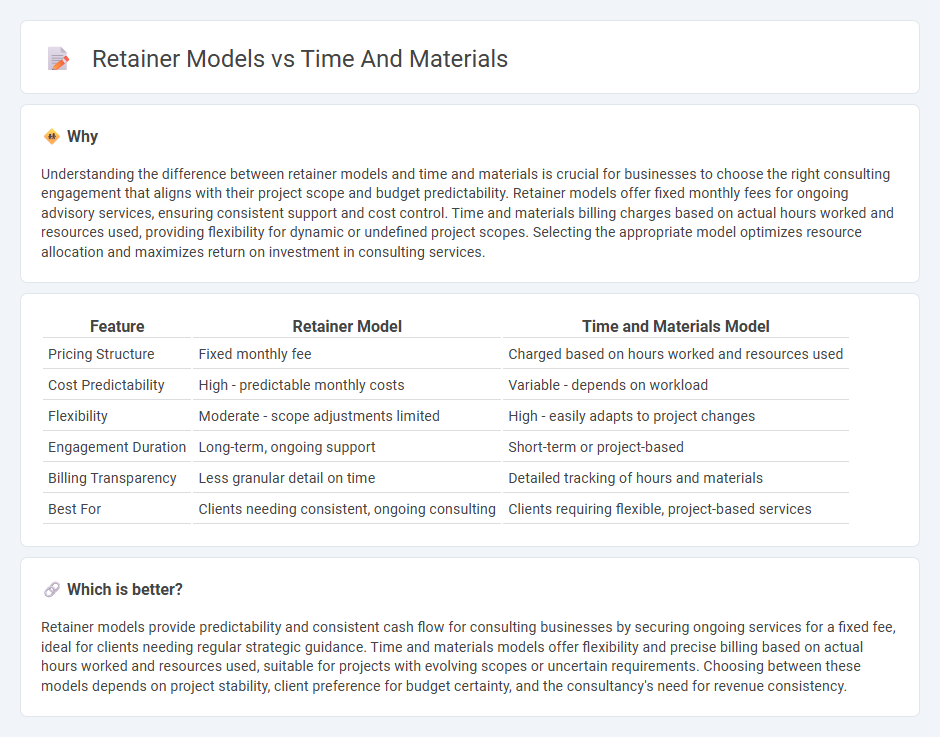
Consulting retainer models provide clients with consistent access to expert advice and strategic support for a fixed monthly fee, ensuring budget predictability and ongoing collaboration. Time and materials contracts bill clients based on actual hours worked and resources used, offering flexibility for projects with evolving scopes and requirements. Explore the advantages and applications of both models to determine the best fit for your consulting needs.
Why it is important
Understanding the difference between retainer models and time and materials is crucial for businesses to choose the right consulting engagement that aligns with their project scope and budget predictability. Retainer models offer fixed monthly fees for ongoing advisory services, ensuring consistent support and cost control. Time and materials billing charges based on actual hours worked and resources used, providing flexibility for dynamic or undefined project scopes. Selecting the appropriate model optimizes resource allocation and maximizes return on investment in consulting services.
Comparison Table
| Feature | Retainer Model | Time and Materials Model |
|---|---|---|
| Pricing Structure | Fixed monthly fee | Charged based on hours worked and resources used |
| Cost Predictability | High - predictable monthly costs | Variable - depends on workload |
| Flexibility | Moderate - scope adjustments limited | High - easily adapts to project changes |
| Engagement Duration | Long-term, ongoing support | Short-term or project-based |
| Billing Transparency | Less granular detail on time | Detailed tracking of hours and materials |
| Best For | Clients needing consistent, ongoing consulting | Clients requiring flexible, project-based services |
Which is better?
Retainer models provide predictability and consistent cash flow for consulting businesses by securing ongoing services for a fixed fee, ideal for clients needing regular strategic guidance. Time and materials models offer flexibility and precise billing based on actual hours worked and resources used, suitable for projects with evolving scopes or uncertain requirements. Choosing between these models depends on project stability, client preference for budget certainty, and the consultancy's need for revenue consistency.
Connection
Retainer models and time and materials (T&M) billing structures both provide flexible consulting arrangements that align service delivery with client needs. Retainer models typically involve a fixed monthly fee guaranteeing priority access to consulting expertise, while T&M charges clients based on actual work hours and materials used. Combining these models allows consultants to ensure steady revenue through retainers while accommodating fluctuating workloads billed via time and materials.
Key Terms
Billing Structure
Time and materials billing charges clients based on actual hours worked and materials used, offering flexibility for projects with evolving scopes. Retainer billing involves clients paying a fixed upfront fee, ensuring dedicated service availability and predictable monthly costs. Explore the benefits and best use cases of each billing structure to optimize your project management strategy.
Scope Flexibility
The time and materials model offers high scope flexibility by allowing adjustments based on evolving project requirements, charging clients for actual hours worked and materials used. In contrast, the retainer model provides a fixed monthly fee that ensures consistent availability but may limit adaptability to changing project demands. Explore each model in detail to determine which best suits your project's scope flexibility needs.
Payment Frequency
Time and materials contracts require payments based on hours worked and materials used, typically invoiced weekly or monthly to maintain cash flow. Retainer models involve a fixed, recurring payment, often monthly, providing consistent budget management and priority access to services. Explore the advantages of each payment frequency model to optimize your project budgeting.
Source and External Links
Time and Materials Contract (T&M): When to Use One & Example - A time and materials contract is a legally binding agreement in which payment is based on the actual time spent and materials used, often including hourly rates for labor and markup on materials, with optional not-to-exceed clauses to cap costs.
Time and Materials (T&M) Contracts: How They Work and When to Use - T&M contracts are suitable when project scope or duration is uncertain, specifying hourly labor rates, materials costs plus markup, and often include maximum price limits like a not-to-exceed clause.
What Is a Time and Materials Contract? - This contract type requires clients to pay contractors for labor time at fixed hourly rates plus the cost of materials with markup, providing payment security for contractors but potentially variable total cost for clients.
 dowidth.com
dowidth.com